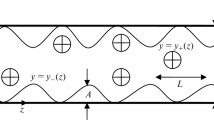Abstract
In experimental investigations of the wake flow behind a plate, a monochromatic (in time) signal is usually observed immediately behind the end of the plate. Downstream, the signal is distorted and then becomes random, i.e., a turbulent flow regime is realized. Theoretically, a branch point is found at the experimentally observed frequency in the spectrum of three-dimensional perturbations of the problem linearized with respect to the steady solution [1]. Mattingly and Criminale [1] attribute all the characteristics of the observed signal to this point. As in other similar investigations, the mechanism of the appearance of the monochromatic signal in the near wake was not elucidated in [1]. In the present paper, the problem of the characteristic oscillations of the flow in the near wake is studied. The appearance of the monochromatic signal is explained by the presence in the near wake of a standing wave of the required frequency, the wave being formed by two scattering points. The first is the end of the plate, and the second the branch point in the spectrum of linear three-dimensional perturbations.
Similar content being viewed by others
Literature cited
G. E. Mattingly and W. O. Criminale, “The stability of an incompressible two-dimensional wake,” J. Fluid Mech.,51, 233 (1972).
L. B. Aizin, “Stability of weakly inhomogeneous states with small addition of white-noise type,” Prikl. Mat. Mekh.,38, 996 (1974).
W. R. Wasow, Asymptotic Expansions for Ordinary Differential Equations, New York (1965).
A. G. Kulikovskii, “Stability of homogeneous states,” Prikl. Mat. Mekh.,30, 148 (1968).
B. Noble, Methods Based on the Wiener-Hopf Technique for the Solution of Partial Differential Equations, Pergamon Press, London (1958).
S. K. Godunov, “Numerical solution of boundary-value problems for systems of linear ordinary differential equations,” Usp. Mat. Nauk,16, 171 (1961).
L. B. Aizin, “Stability of weakly inhomogeneous flows with a small rapidly varying addition,” Candidate's Dissertation [in Russian], Novosibirsk (1979).
Author information
Authors and Affiliations
Additional information
Translated from Izvestiya Akademii Nauk SSSR, Mekhanika Zhidkosti i Gaza, No. 6, pp. 68–72, November–December, 1983.
Rights and permissions
About this article
Cite this article
Aizin, L.B., Volodin, A.G. Stability of an incompressible two-dimensional wake. Fluid Dyn 18, 890–894 (1983). https://doi.org/10.1007/BF01090743
Received:
Issue Date:
DOI: https://doi.org/10.1007/BF01090743




